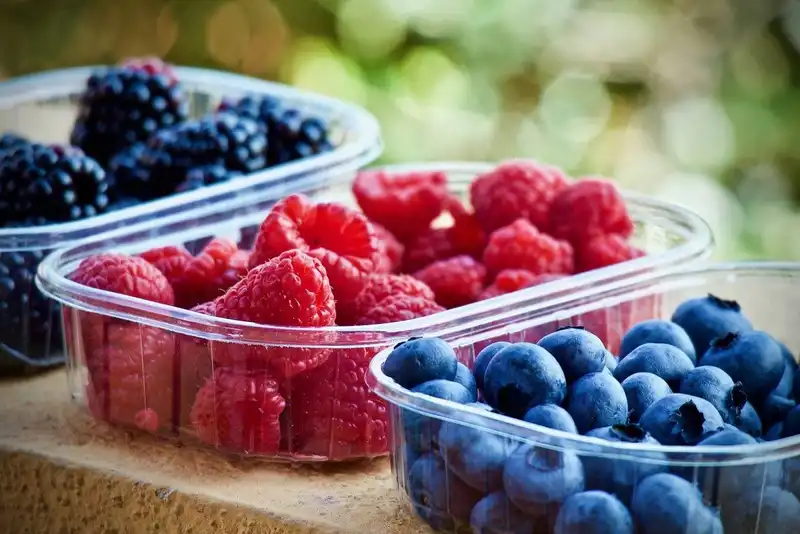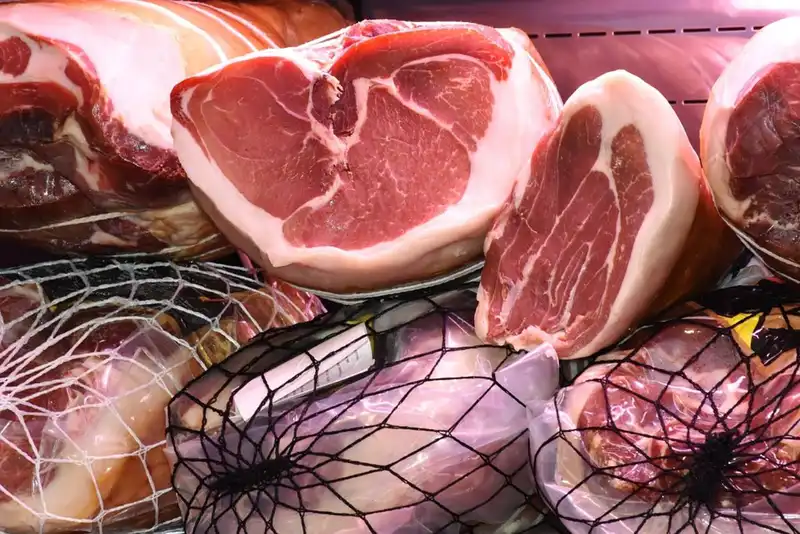Food Storage Do's and Don'ts- How to Properly Store Your Food

Food Storage Importance
Long term food storage is an unavoidable part of the food industry. Common examples of situations where storage techniques are necessary to include salad bars, transportation to off-site locations, catering events, and buffet lines. Proper storage of food is essential to preventing foodborne illness outbreaks, decreasing food wastefulness, and increasing overall business efficiency and bottom-line profitability.
Maintain proper storage temperatures by carefully monitoring the temperatures of all of your food products and avoid time spent in the danger zone. Discard food that is stored at the wrong temperature to avoid foodborne illnesses. The storage methods hot holding and cold holding are essential to food safety compliance and decreasing foodborne illness.
Securely covering leftovers in storage containers greatly decreases the likelihood of outside contamination. Clearly label food storage containers with a date made or use by date in order to consume foods before expiration and decrease your food waste footprint. Label and check both opened and unopened food containers regularly to ensure freshness. Prevent cross-contamination by keeping raw and ready to eat (RTE) foods separate from each other.
Types of Food Storage

Storage of food can be categorized into two areas, perishable foods, and dry goods. When storing perishable foods in freezers or refrigerators, separate ready-to-eat foods (food that is already edible and needs no additional preparation) from raw foods (food that needs preparation in order to be edible).
Ideally, various food groups would have separate storage containers, but this is not possible in many kitchens. Below you will find some tips for short term perishable storage if your business is not able to accommodate separate storage units.
Tips for storage of perishables-
- Make sure to store food that has been cut or prepared and will not be cooked in the uppermost shelves
- Store fruits and vegetables that have not been cut or prepared below RTE foods as raw produce contains bacteria from soil
- Store raw meats and fish below the above items. These foods have the highest amount of bacteria and are most likely to cause harm should cross-contamination occur
- Store shellfish separately from everything else, due to the severity of allergic reactions
- Make sure all food storage containers are covered, date coded, and labeled, in order to maintain a proper stock rotation system
- Use the first-in, first-out (FIFO) system
FIFO (first-in, first-out), is a stock rotation system that stores and uses older food products before newer products. By organizing your product with the earliest best buy or use-by dates at the front and items with the latest dates at the back, your staff is encouraged to use older products before they spoil.
The 5 FIFO procedures for proper food rotation-
- Identify food products that will expire soonest by their best before or use-by date
- Extract both damaged and expired food products for disposal
- Position remaining food products with the closest expiration date at the front. Continue this process so that the closest food product to the front is the closest to its expiration date and the closest food product to the back is the farthest from its expiration date
- Use or sell the food products at the front first
Proper storage of dry or dried food includes many of the same principles as the storage of perishable food. Safe storage of dry food is often overlooked, as long term food storage products are so durable. However, food industry professionals must be wary of the fact that dry storage areas are more likely to encounter chemical and physical contamination than cold storage.
Keeping your dry storage products in dry, dark spaces away from direct sunlight will maximize your food shelf life, help control temperature, and prevent unnecessary food waste. Keep humidity levels lower than 15% with moisture-proof packaging and air conditioning when necessary.
Make sure to place ever food storage container at least six inches from the floor and walls, and one foot from the ceiling to avoid contaminants and vermin.
Tips for storage of dry foods-
- Always cover and seal opened goods
- Store dry or dried food below 46 degrees Fahrenheit for maximum shelf life
- Keep dry long term food storage areas clean
- Make sure there is ideal ventilation in order to control humidity and inhibit the growth of mold and harmful bacteria
- Install a thermometer on the wall in the dry storage area
- Check the temperature of the dry long term food storage area frequently
With 21% of restaurant food waste due to food spoilage and 48 million Americans getting sick as a result of foodborne diseases every year, proper food storage etiquette is essential to the sustainable and safe food supply.
Proper Egg Storage

Proper storage of eggs is an essential part of a compliant storage system. Below are tips on storing eggs as efficiently and safely as possible.
1. Keep eggs in their original carton-
- Protect the eggs from damage
- Prevent absorption of strong odors of other foods in your fridge
- Prevent absorption of strong flavors of other foods in your fridge
- Allow easy reference of best before date
- Provide proper positioning of the egg to help keep the yolk centered
2. Store properly-
- Place the carton in the main body of the fridge to ensure a consistent, cool temperature
- Do not store carton on the fridge door
- Put leftover raw egg whites and yolks in airtight containers
- Refrigerate securely-covered leftovers immediately
- Cover yolks with a little cold water to prevent them from drying out. Remember to drain the water before using the leftovers
- Do not mind the sulfur smell from storing hard-boiled eggs, it is harmless and usually disperses in a few hours
Proper Bread Storage

Proper storage of bread is an essential part of a compliant storage system. Below are tips on storing bread as efficiently and safely as possible.
Do-
- Wrap bread in a dish towel or paper bag.
- Store in a dry and clean environment.
- Freeze-dried bread can last longer in storage- up to one month. This is the only exception to wrapping bread in plastic in order to prevent freezer burn.
- Keep in mind that generally- the bigger the bread, the longer the shelf life.
Do not-
- Store your bread in plastic. Plastic encourages mold growth and produces an unpleasant chewy texture. The only exception is when freezing bread in order to prevent freezer burn.
- Store your bread in the refrigerator as it will speed up the staling process.
- Store in a damp or unclean environment.
Proper Meat Storage

Proper storage of meat is an essential part of a compliant storage system. Below are tips on storing meat as efficiently and safely as possible.
- Wrap it- raw meat contaminates everything it touches. Prevent cross-contamination by correctly wrapping and storing meat. Never leave raw meat open in your refrigerator. Securely wrap meat in cellophane to prevent juice leakage.
- Mark it- clearly label the contents of the package, date made, and the use-by date.
- Store it- place raw meat in its correct hierarchy refrigerator shelf position- below prepared foods, fruits and veggies, and seafood but above ground meat and poultry. If freezing meat and poultry in its original package longer than 2 months, cover with heavy-duty foil, plastic wrap on freezer paper, or inside a freezer bag.
Proper Produce Storage

Proper storage of produce is an essential part of a compliant storage system. For optimal shelf life and quality, food industry professionals should research specific short term storage times for different produce items. Some produce stays fresh longest in a cool or room-temperature location away from heat, light, and moisture.
When some produce items see sunlight they react as if they are still outside and start to sprout. Common examples of cool or room temperature preferring produce items include onions, shallots, garlic, all types of potatoes (including yams and sweet potatoes), and hard squash like winter, acorn, spaghetti, and butternut. Other produce stays fresh longest in a refrigerated environment. When storing refrigerated produce, remember that low humidity is best for some fruits, while high humidity is best for vegetables.
Keep fruit and vegetable products separate in order to avoid accelerated spoilage or excess moisture. While many fruits should be stored on the countertop, no vegetables should. Preparation of produce may lengthen or shorten produce shelf life, including peeling or washing. A helpful rule of thumb is that anything whole will last longer than anything cut, and anything cut or peeled should be stored in the fridge.
Improper Food Storage Consequences
When so many foods are originating from the same sources, it is especially important to maintain correct storage throughout the food supply chain to decrease foodborne illness outbreaks.
Only work with third parties who use proper temperature controls during storage and transit. Before you accept shipments, ensure the products are at a safe temperature and refuse any products that arrive in the danger zone range.
Consequences include-
- Unnecessary food waste
- Wasting money and resources on spoiled or stale food
- Increasing foodborne illness and food outbreaks
- Decreasing overall business efficiency and profitability
- Moldy, contaminated, stale, or rotten food products
Proper Food Storage Benefits

Benefits of proper food storage include-
- Optimization and monitoring of food shelf life
- Improving food safety skills among food industry professionals
- Less food waste production
- Protection of customers against food outbreaks and decreasing foodborne illness transmission
- Control of temperature and avoidance of the danger zone
- Producing the best results possible during health inspections and internal quality checks
- Maintaining safer and better quality food
- Avoidance of overstocking with more efficient storage system
- Prevent biological (eg. bacteria), chemical (eg. concentrated chemicals), physical (eg. wood splitters) contamination
Improper storage costs billions of dollars annually worldwide. Food industry professionals using an appropriate storage system will increase overall business efficiency and bottom-line profitability while decreasing food wastefulness and food outbreaks.
Utilize proper storage to provide the highest quality and safest products possible- your consumers will be safer and more satisfied as a result!
Conclusion
- Holding and storing food for prolonged periods of time is an unavoidable part of the food industry. Common examples of situations where storage techniques are necessary to include salad bars, transportation to off-site locations, catering events, and buffet lines.
- Storage of food can be categorized into two areas, perishable foods, and dry goods.
- When storing perishable foods in freezers or refrigerators, separate ready-to-eat foods (food that is already edible and needs no additional preparation) from raw foods (food that needs preparation in order to be edible).
- Food industry professionals must be wary of the fact that dry storage areas are more likely to encounter chemical and physical contamination than cold storage.
- Keeping your dry storage products in dry, dark spaces away from direct sunlight will maximize your food shelf life, help control temperature, and prevent unnecessary food waste.
- With 21% of restaurant food waste due to food spoilage and 48 million Americans getting sick as a result of foodborne diseases every year, proper storage etiquette is essential to running a sustainable and safe business.
- When so many foods are coming from and being stored by the same sources, it is especially important to maintain correct storage throughout the food supply chain to decrease food outbreaks.
- Proper storage of food is essential to preventing food outbreaks, decreasing food wastefulness, and increasing overall business efficiency and bottom-line profitability.